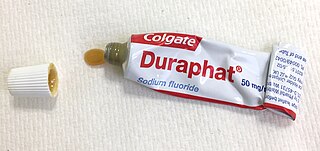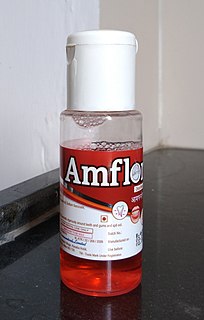
Toothpaste is a paste or gel dentifrice used with a toothbrush to clean and maintain the aesthetics and health of teeth. Toothpaste is used to promote oral hygiene: it is an abrasive that aids in removing dental plaque and food from the teeth, assists in suppressing halitosis, and delivers active ingredients to help prevent tooth decay and gum disease (gingivitis). Salt and sodium bicarbonate are among materials that can be substituted for commercial toothpaste. Large amounts of swallowed toothpaste can be toxic.

Tooth enamel is one of the four major tissues that make up the tooth in humans and many other animals, including some species of fish. It makes up the normally visible part of the tooth, covering the crown. The other major tissues are dentin, cementum, and dental pulp. It is a very hard, white to off-white, highly mineralised substance that acts as a barrier to protect the tooth but can become susceptible to degradation, especially by acids from food and drink. Calcium hardens the tooth enamel. In rare circumstances enamel fails to form, leaving the underlying dentin exposed on the surface.

Tooth decay, also known as dental caries or cavities, is the breakdown of teeth due to acids made by bacteria. The cavities may be a number of different colors from yellow to black. Symptoms may include pain and difficulty with eating. Complications may include inflammation of the tissue around the tooth, tooth loss, and infection or abscess formation.

Water fluoridation is the controlled adjustment of fluoride to a public water supply to reduce tooth decay. Fluoridated water contains fluoride at a level that is effective for preventing cavities; this can occur naturally or by adding fluoride. Fluoridated water operates on tooth surfaces: in the mouth, it creates low levels of fluoride in saliva, which reduces the rate at which tooth enamel demineralizes and increases the rate at which it remineralizes in the early stages of cavities. Typically a fluoridated compound is added to drinking water, a process that in the U.S. costs an average of about $1.11 per person-year. Defluoridation is needed when the naturally occurring fluoride level exceeds recommended limits. In 2011 the World Health Organization suggested a level of fluoride from 0.5 to 1.5 mg/L, depending on climate, local environment, and other sources of fluoride. Bottled water typically has unknown fluoride levels.
Tooth whitening or tooth bleaching is the process of lightning the color of human teeth. Whitening is often desirable when teeth become yellowed over time for a number of reasons, and can be achieved by changing the intrinsic or extrinsic color of the tooth enamel. The chemical degradation of the chromogens within or on the tooth is termed as bleaching. Hydrogen peroxide is the active ingredient most commonly used in whitening products and is delivered as either hydrogen peroxide or carbamide peroxide. Hydrogen peroxide is analogous to carbamide peroxide as it is released when the stable complex is in contact with water. When it diffuses into the tooth, hydrogen peroxide acts as an oxidising agent that breaks down to produce unstable free radicals. In the spaces between the inorganic salts in tooth enamel, these unstable free radicals attach to organic pigment molecules resulting in small, less heavily pigmented components. Reflecting less light, these smaller molecules create a "whitening effect". There are different products available on the market to remove stains. For whitening treatment to be successful, dental professionals should correctly diagnose the type, intensity and location of the tooth discolouration. Time exposure and the concentration of the bleaching compound, determines the tooth whitening endpoint.

Ameloblasts are cells present only during tooth development that deposit tooth enamel, which is the hard outermost layer of the tooth forming the surface of the crown.
Fluoride or fluorine deficiency is a disorder which may cause increased dental caries and possibly osteoporosis, due to a lack of fluoride in the diet. Common dietary sources of fluoride include tea, grape juice, wine, raisins, some seafoods, coffee, and tap water that has been fluoridated. The extent to which the condition truly exists, and its relationship to fluoride poisoning has given rise to some controversy. Fluorine is not considered to be an essential nutrient, but the importance of fluorides for preventing tooth decay is well-recognized, although the effect is predominantly topical. Prior to 1981, the effect of fluorides was thought to be largely systemic and preeruptive, requiring ingestion. Fluoride is considered essential in the development and maintenance of teeth by the American Dental Hygienists' Association. Fluoride is also essential as it incorporates into the teeth to form and harden teeth enamels so that the teeth are more acid resistant as well as more resistant to cavity forming bacteria. Caries-inhibiting effects of fluoride were first believed to have been seen in 1902 when fluoride in high concentrations was found to stain teeth and prevent tooth decay.

Abrasion is the non-carious, mechanical wears of tooth from interaction with objects other than tooth-tooth contact. It most commonly affects the premolars and canines, usually along the cervical margins. Based on clinical surveys, studies have shown that abrasion is the most common but not the sole aetiological factor for development of non-carious cervical lesions (NCCL) and is most frequently caused by incorrect toothbrushing technique.

Fluoride therapy is the use of fluoride for medical purposes. Fluoride supplements are recommended to prevent tooth decay in children older than six months in areas where the drinking water is low in fluoride. It is typically used as a liquid, pill, or paste by mouth. Where public water supplies are fluoridated further fluoride by mouth is typically not needed. Fluoride has also been used to treat a number of bone diseases.

Dental fluorosis is a common disorder, characterized by hypomineralization of tooth enamel caused by ingestion of excessive fluoride during enamel formation.

Tooth development or odontogenesis is the complex process by which teeth form from embryonic cells, grow, and erupt into the mouth. For human teeth to have a healthy oral environment, all parts of the tooth must develop during appropriate stages of fetal development. Primary (baby) teeth start to form between the sixth and eighth week of prenatal development, and permanent teeth begin to form in the twentieth week. If teeth do not start to develop at or near these times, they will not develop at all, resulting in hypodontia or anodontia.
Olaflur is a fluoride-containing substance that is an ingredient of toothpastes and solutions for the prevention of dental caries. It has been in use since 1966. Especially in combination with dectaflur, it is also used in the form of gels for the treatment of early stages of caries, sensitive teeth, and by dentists for the refluoridation of damaged tooth enamel.

Fluoride varnish is a highly concentrated form of fluoride which is applied to the tooth's surface, by a dentist, dental hygienist or other health care professional, as a type of topical fluoride therapy. It is not a permanent varnish but due to its adherent nature it is able to stay in contact with the tooth surface for several hours. It may be applied to the enamel, dentine or cementum of the tooth and can be used to help prevent decay, remineralise the tooth surface and to treat dentine hypersensitivity. There are more than 30 fluoride-containing varnish products on the market today, and they have varying compositions and delivery systems. These compositional differences lead to widely variable pharmacokinetics, the effects of which remain largely untested clinically.

Tooth remineralisation is the natural repair process for non-cavitated tooth lesions, in which calcium, phosphate and sometimes fluoride ions are deposited into crystal voids in demineralised enamel. Remineralisation can contribute towards restoring strength and function within tooth structure.

Enamel hypoplasia is a defect of the teeth in which the enamel is deficient in amount, caused by defective enamel matrix formation. Defects are commonly split into one of four categories, pit-form, plane-form, linear-form, and localised enamel hypoplasia. In many cases the enamel crown has pits or a groove on it, and in extreme cases, sections of the tooth have no enamel, exposing the dentin. Enamel hypoplasia varies substantially among populations and can be used to infer health and behaviour in past populations. Defects have also been found in a variety of non-human animals.

Amelogenesis imperfecta (AI) is a congenital disorder which presents with a rare abnormal formation of the enamel or external layer of the crown of teeth, unrelated to any systemic or generalized conditions. Enamel is composed mostly of mineral, that is formed and regulated by the proteins in it. Amelogenesis imperfecta is due to the malfunction of the proteins in the enamel as a result of abnormal enamel formation via amelogenesis.

Amine fluorides are dental drugs.
Silver diammine fluoride, (SDF) also known as Silver diamine fluoride in most of the dental literature, is a topical medication used to treat and prevent dental caries and relieve dentinal hypersensitivity. It is a colorless or blue-tinted, odourless liquid composed of silver, ammonium and fluoride ions at a pH of 10.4 or 13. Ammonia compounds reduce the oxidative potential of SDF, increase its stability and helps to maintain a constant concentration over a period of time, rendering it safe for use in the mouth. Silver and Fluoride ions possess antimicrobial properties and are used in the remineralization of enamel and dentin on teeth for preventing and arresting dental caries.

Tooth discoloration is abnormal tooth color, hue or translucency. External discoloration is accumulation of stains on the tooth surface. Internal discoloration is due to absorption of pigment particles into tooth structure. Sometimes there are several different co-existent factors responsible for discoloration.
Enamel microabrasion is a procedure in cosmetic dentistry used to improve the appearance of the teeth. Like tooth whitening it is used to remove discolorations of the tooth surface but microabrasion is a both a mechanical and chemical procedure.















